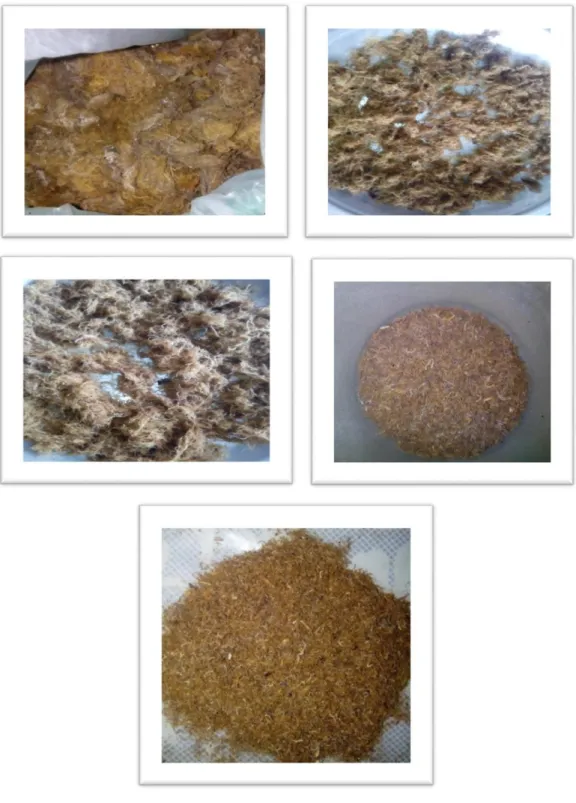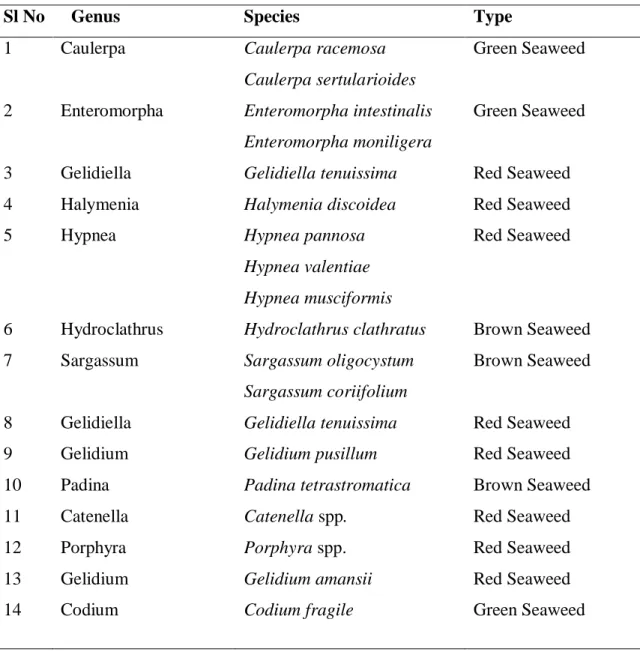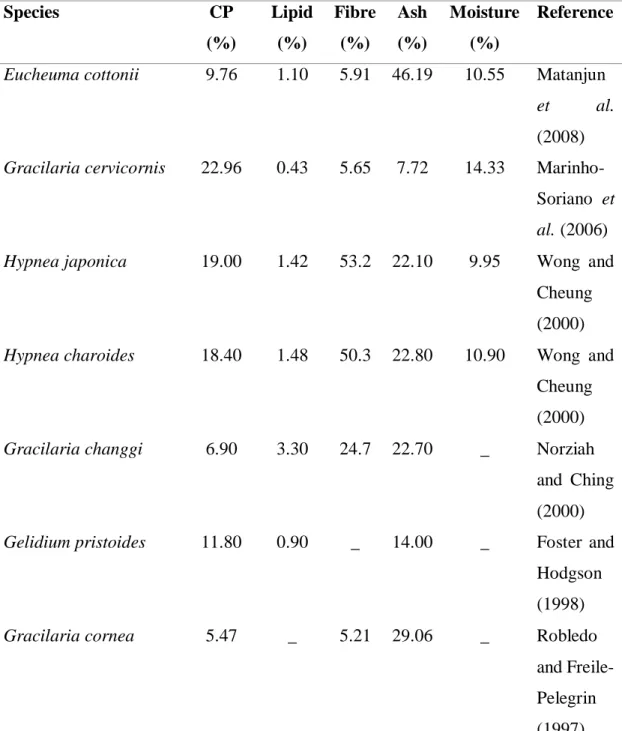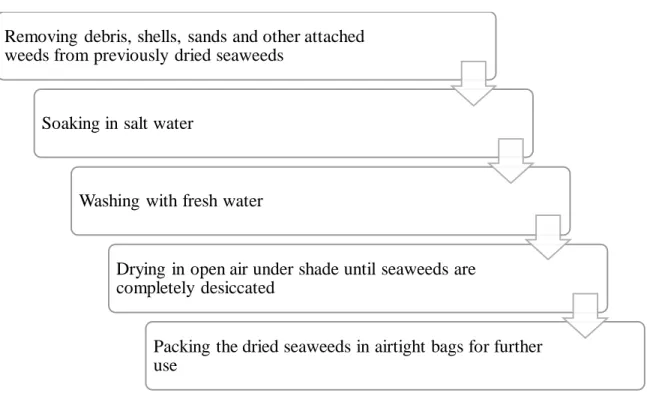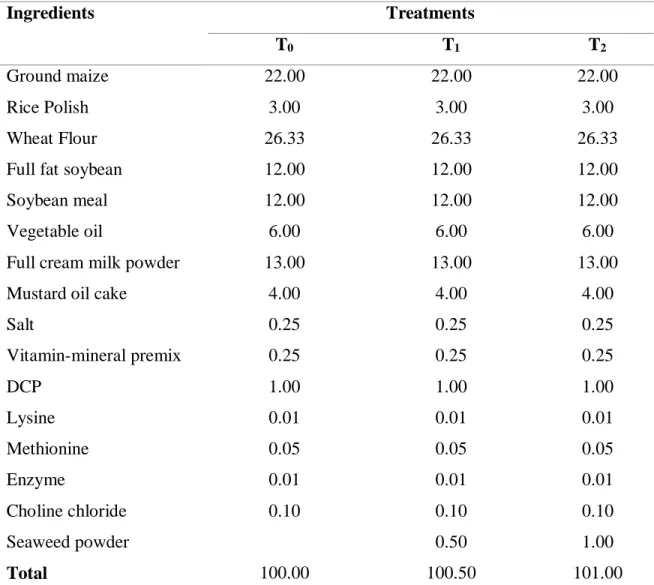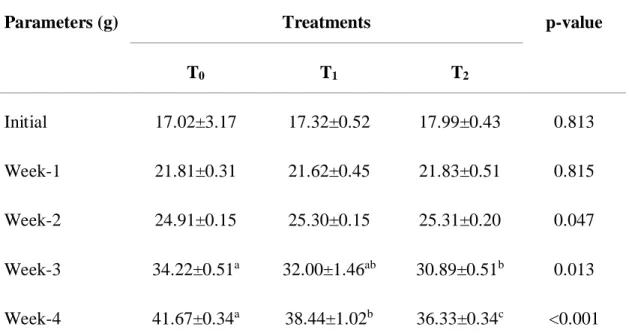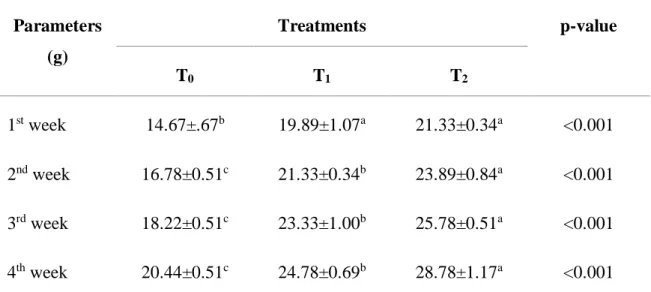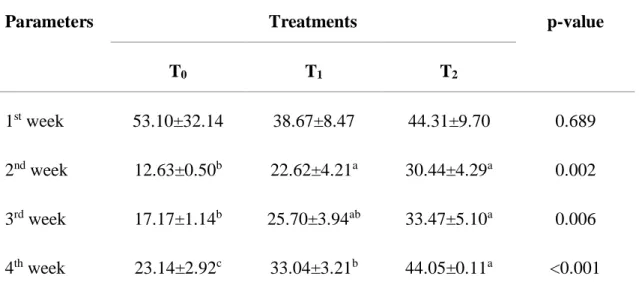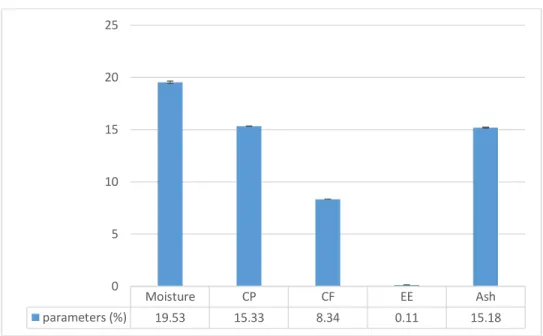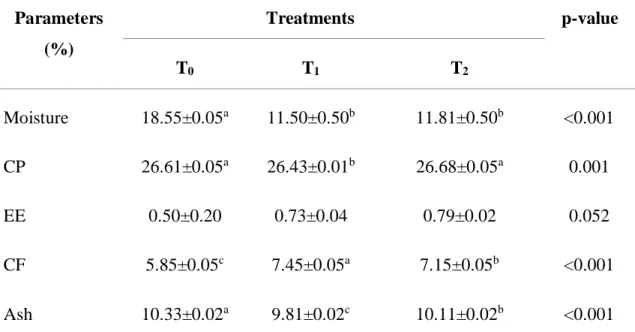I sincerely thank all the members of the Department of Physiology, Biochemistry and Pharmacology and Poultry Research and Training Center (PRTC) for allowing me to work in the laboratory. A significant difference was observed in the average daily food intake (ADFI) (p<0.001) between the treatment groups for each week of the experiment. Seaweeds are macroscopic marine algae that have the morphological characteristic to attach and colonize on the hard substrate and shallow water area of the seashore, which is suitable for their massive growth.
Phytoplanktons are microscopic and free-floating forms; they are the main producers of the sea. Seaweed contributes to the ocean's primary production and therefore seaweed beds are considered a highly productive and dynamic ecosystem. In Bangladesh, the natural abundance of seaweed is reported from the southeastern part of the mainland and offshore island. The island of Saint Martin has a rocky substrate suitable for the natural growth of seaweed.
Sarker, 1992) is a red alga that lives in shallow tropical and subtropical marine environments (Guist et al., 1982). The coastal areas of Bangladesh are one of the most unreached areas in the world in terms of phycology. A case-control study on seaweed consumption and breast cancer risk was conducted by (Yang et al., 2010).
Another researcher is working on the effects of edible seaweed on the metabolic activities of intestinal microflora in rats (Gomez et al., 2012).
History of seaweed
Disposing of these by-products is not justified from a social, economic and environmental perspective, given the fact that these by-products contain valuable bioactives (e.g., health-promoting biochemicals), fine biochemicals (e.g., dyes and pigments) and biomolecules (eg, proteins, oils, etc.).
Intervention of seaweed to enhance human nutrition
- Carbohydrates
- Proteins
- Lipids
- Vitamins
- Minerals
The levels of these proteins are comparable to those of the FAO/WHO dietary protein requirements (Anonymous, 2006). Therefore, most of the edible red seaweed can be considered as a good source of protein to be included in the diet. In addition, Spirulina, the blue-green algae, is well known for its very high protein content which is close to 70% of the dry matter.
However, the extractability and in vitro digestibility of seaweed proteins reach more than 80% regardless of species (Fleurence, 1999). However, lipid content and fat composition can be very different depending on the type of seaweed. This high vitamin E content in seaweed helps protect the PUFAs in the seaweed to preserve their nutritional benefits.
In addition, a typical serving size of the brown seaweeds Laminaria spp and Undaria spp provides more than 50% of the recommended daily intake of magnesium. Therefore, the body's needs for the most important minerals can be fulfilled by adding seaweed as food.
Nutritive value of seaweed
Seaweed can be considered the best cheap source to meet human iodine needs as animal and plant foods contain very low iodine content. Seaweed contains significantly high amounts of iron and copper compared to food sources, although meat and spinach are well known to contain these minerals (Holland et al., 1993).
Available seaweed species
Commercially important seaweed species
Natural production of seaweeds
Seasonal variation in seaweeds’ availability
Proximate composition
Micronutrients contents
Nutrition-related health benefits of seaweed
Reduction of obesity by bringing down the caloric value of the diet
Reduction of lipid absorption and cardiovascular diseases
Influence on glycemic control
Uses of Seaweeds
Ulva sp., Enteromorpha sp., Caulerpa sp., Codium sp., Monostroma sp., Sargassum sp., Hydroclathrus sp., Laminaria sp., Undaria sp., Macrocystis sp., Porphyra sp., Gracilaria sp., Eucheuma sp. . ., Laurencia sp. In Philippines people eat Caulerpa lentiifera as salad and Codium tomentosum, Eucheuma denticulatum and Kappaphycus alvarezii in the form of curry. Seaweed can be used in the production of commercial food products such as jelly from Gelidiella sp.
Seaweed contains all the essential amino acids needed in the human diet, which are not available in plant foods. Seaweeds are not eaten in India, except for jelly made from agar and porridge made from Gracilaria edulis in the coastal areas of Ramanathapuram district. Agar is added in the preparation of the following foods – ice cream, tomato sauce, jelly, marmalade, blancmange and lime jelly (Kolanjinathan et al., 2014).
Carbohydrates and other organic matter present in seaweed change the nature of the soil and improve its moisture holding capacity. In China and Japan, seaweed was used to treat goiter and other glandular diseases.
Utilization of naturally occurring seaweed in Bangladesh
Conventional utilization
Approaches for seaweed utilization by government organization
Approaches for seaweed utilization by private entrepreneur and non-
Study area and period
Collection of seaweed
Processing of seaweed
Collection of raw materials for feed
Preparation of mice ration
Collection of mice
Experimental Model
Preparation of shed
Observation of growth performance
Live weight gain
Feed intake
Feed conversion ratio (FCR)
Proximate analysis of seaweed and mice feed
- Determination of Moisture content
- Determination of Ash content
- Determination of Crude Fiber (CF)
- Determination of Crude Protein (CP)
- Determination Ether Extract
The enamel disk or crucible was dried in a hot air oven regulated at 105°C, cooled in a desiccator and weighed. 5 g of dry seaweed sample, seaweed crackers, local crackers and control crackers were weighed into the crucibles and burned to no smoke in heater. The oven was cooled to 150°C and the samples were transferred to a desiccator and weighed (AOAC, 1995).
It was boiled for 30 minutes and removed from the heater, which was cooled and filtered through filter cloth. 10 ml of concentrated H2SO4 was added and the digestion flask was placed in Kjeldahl Digestion Set. Then the heat was gradually increased and continued until the residue became clear (45 minutes to 1 hour).
We added 40 ml of 40% NaOH and continued the distillation until 100 ml of distillate. The ether extract content of dried seaweed was determined by the Soxhelt method (AOAC, 1995) using petroleum ether (60-80ºC) as solvent in the SOCS PLUS –SCS system. For fat extraction, approximately 2.0 g of the final ground sample was placed in cellulose thimble paper and fat extraction was performed with hexase in a 250 mL Soxhlet extractor for 3 hours.
Mineral analysis of seaweed
Biochemical analysis of mice blood
From these sera, various biochemical tests such as total cholesterol (TC), triglyceride (TG), high density lipoprotein (HDL) were determined using biochemical analyzer (Humalyzer 3000, Human® Diagnostics, Germany), glucose, total protein, calcium , phosphorus in the physiology laboratory of CVASU by following the instructions supplied with the kits (Randox® Laboratories limited, UK).
Statistical analysis
Effects on Growth performance
- Live weight
- Average daily gain
- Average daily feed intake
- Feed conversion ratio (FCR)
The data presented in Table 7 showed a significant decrease (p<0.05) in the average gross daily gain (ADG) in all treatment groups compared to the control. Weekly ADG in the first and second week showed a non-significant decrease (p>0.05) in the T1 and T2 groups in contrast to the T0 group, while in the third and 4th week the ADG significantly differed (p<0.05) in the T1 groups and T2 in comparison. to T0. The average daily food intake (ADFI) shown in Table 8 showed significant differences (p<0.001) among all dietary groups throughout the study period.
The feed conversion ratio in Table 9 showed a significant (p<0.001) difference in FCR in all treatment groups compared to control at 2nd and 3rd week.
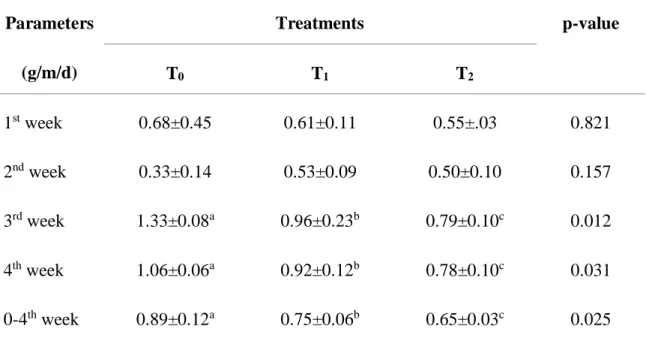
Proximate analysis of seaweed
Proximate analysis of mice ration
Mineral contents of Seaweed
Blood parameters
Blood glucose
Blood Lipid profile
Blood total protein and mineral contents
The results of this study, conducted to investigate the dietary effects of seaweed (Hypnea musciformis) on growth performance and blood parameters (blood glucose, lipid profile, total protein, and serum calcium and serum phosphorus) are discussed in this chapter. The maximum weight loss was observed in the T2 group which was fed with 1.0% seaweed powder. This difference in result may be due to different types of seaweed used, different feed formula and due to climatic conditions.
In the 1st week of the trial there was no significant change among the treatment groups, but in the 2nd and 3rd weeks there was a significant increase in FCR. seaweed supplement, showed the highest FCR from the 2nd week to the last week of the experiment. 2013), applied seaweed to broilers and found no significant effect in FCR. Page | 37 The proximate chemical composition of Hypnea musciformis seaweed was evaluated to understand the nutritional value of the species. The highest blood glucose level was observed in the T1 group which was treated with 0.5% seaweed powder.
In this study, while the lipid profile was measured, a significant decrease in serum cholesterol level was found in the treatment groups compared to the control group. Serum triglyceride level was also significantly reduced in the treatment groups compared to the control group. The result was consistent with a similar study where Hypnea musciformis was applied to rabbit to see the change in the blood parameters (Najam et al., 2010).
The serum calcium level of the treatment groups was significantly higher compared to the control group. The nutritional properties of the red seaweed species suggested that it has potential nutritional value and could be used as a functional ingredient in our food industry. However, the seaweed industry in Bangladesh is still in its early stages and people in Bangladesh are still not aware of the potential of seaweed.
Effect of ingestion of Mastocarpusstellatus from red seaweed on lipid metabolism and antioxidant status in healthy Wistar rats. Inhibitory effect of konjac mannan on bile acid transport in the everted sacs of the rat ileum. Development of value added products from seaweed available in the Bay of Bengal, coastal Bangladesh.
Non-starch polysaccharides extracted from seaweed can modulate intestinal glucose absorption and insulin response in the pig. Changes in the content of dietary fiber, minerals, free amino acids and fatty acids during the processing of dry Nori.
